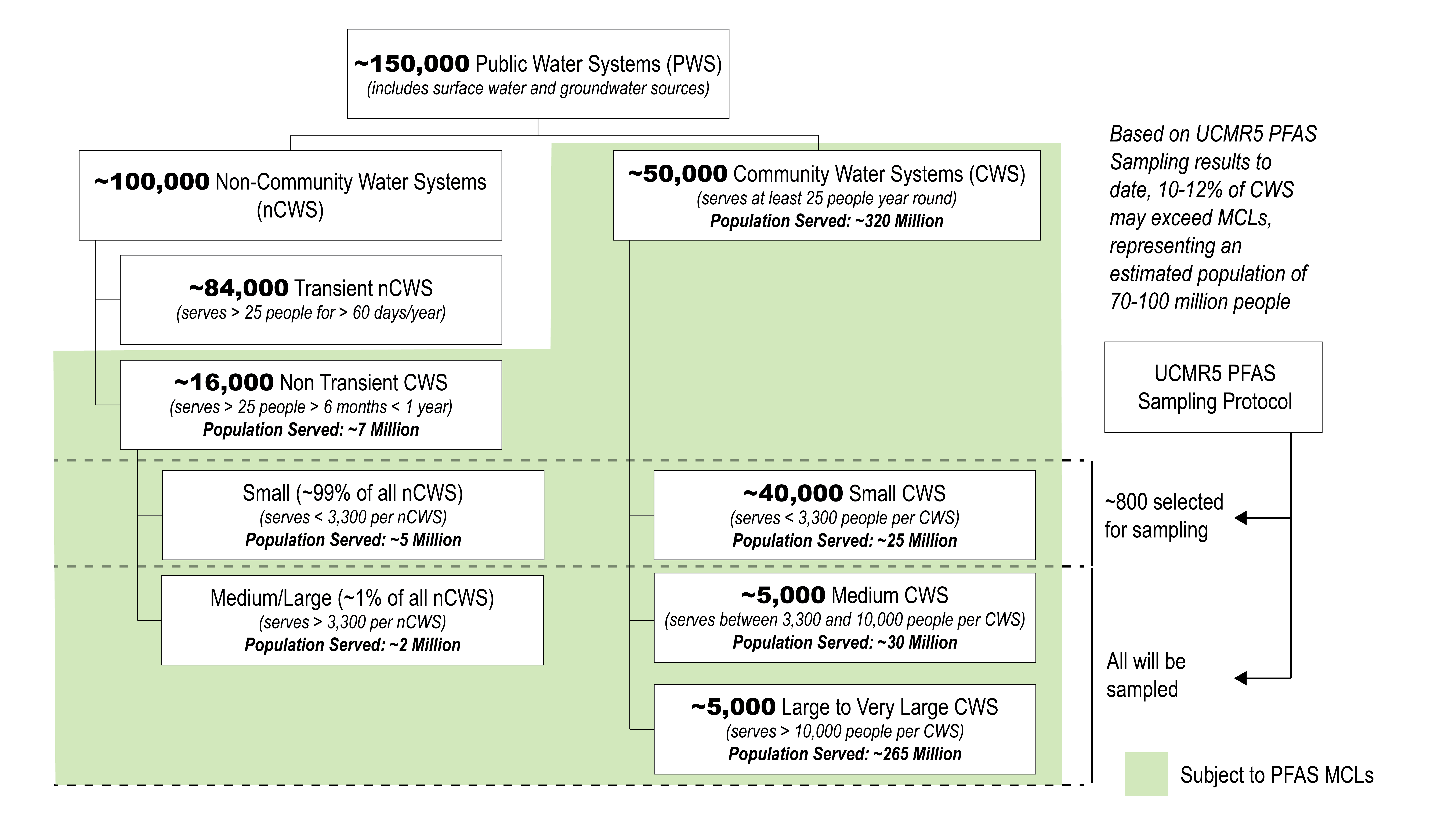Since the U.S. Environmental Protection Agency (EPA) published the proposed National Primary Drinking Water Regulation rule for per- and polyfluoroalkyl substances (PFAS) in March 2023, more than 120,000 comments were received from industry, government agencies, and from the public at large. On 10 April, EPA released a long anticipated final National Primary Drinking Water Regulation for six PFAS (link to rule will open in a new tab). This rule outlines both unenforceable maximum contaminant level goals (MCLGs) and enforceable maximum contaminant levels (MCLs). EPA set MCLs with specific maximum concentrations for PFOA, PFOS, PFHxS, HFPO-DA (GenX), and PFNA and set a limit for mixtures of two more of either PFHxS, PFNA, HFPO-DA, and PFBS to a hazard index (HI) of 1. The table below describes both MCLGs and MCLs for the six PFAS.
| Chemical | MCLG | MCL |
|---|---|---|
| PFOA | 0 | 4 ppt |
| PFOS | 0 | 4 ppt |
| PFHxS | 10 ppt | 10 ppt |
| HFPO-DA (GenX Chemicals) | 10 ppt | 10 ppt |
| PFNA | 10 ppt | 10 ppt |
| Mixture of two or more: PFHxS, PFHA, HFPO-DA, and PFBS | HI of 1 | HI of 1 |
Notes:
HI – hazard index
ppt – parts per trillion
Compliance is determined by running annual averages at the sampling point.
Source: EPA (link to rule will open in a new tab)
MCLs, which are enforceable by EPA, are based, in part, on a linear no-threshold dose-response model that is geared largely towards protecting people from cancer due to exposure to the two of the highest profile and most studied PFAS (PFOA and PFOS). EPA’s default position for these two PFAS is that no amount of exposure is safe, thus the rationale behind setting unenforceable MCLGs to zero. However, since zero is not measurable, EPA is tying the MCL to the lowest concentration that analytical instruments can reliably detect.
About PFAS
PFAS are a broad class of fluorinated anthropogenic chemicals, which include PFOA and PFOS. Thousands of synthetic fluorinated chemicals are known to have been used in a wide variety of manufacturing processes, consumer products, and specialty applications by commercial, military, and other sectors.
Affected Water Systems
Figure 1 illustrates the breakout of approximately 150,000 private and publicly owned drinking water systems, generally referred to as public water systems (PWS) in the United States. The PWS network consists of nearly 50,000 community water systems (CWS) that provide a daily average of 39 billion gallons to approximately 320 million people year-round. This CWS network ranges from small (at least 25 people) to large systems serving at least 10,000 to more than 1 million people. There are also approximately 100,000 non-CWS (nCWS) used by transient and non-transient populations that in aggregate, serve approximately 7 million people over periods ranging from months to less than 1 year. All CWS and non-transient nCWS are subject to the new rule as shown on the following figure.

Source: EPA The Fifth Unregulated Contaminant Monitoring Rule Fact Sheet (Linked document will open in a new tab), published December 27, 2021
Based on three rounds of PFAS sampling from a cross section of what will eventually be approximately 10,000 representative PWS under the fifth iteration of the Unregulated Contaminant Monitoring Rule (UCMR5), it is estimated that approximately 10 to 12 percent of all PWS will report levels of one or more of the six regulated PFAS above MCLs (Figure 1). This percentage of PWS conservatively represents somewhere between 70-100 million affected people (sources: EPA and American Water Works Association [AWWA]). There are also provisions for PWS to notify the public on monitoring results and exceedances of MCLs. PWS that are found to exceed criteria must take action to reduce PFAS to below these MCLs within 5 years.
The impact of this rulemaking will be felt by the nearly 66,000 PWS covered under this rule that will be required to start monitoring for these PFAS within 3 years. EPA estimates that between 3,400 and 6,300 water systems will be affected by the regulation and be required to treat PFAS in drinking water.
This regulation primarily focuses on requiring PWS to address PFAS contamination; however, it is not aimed at holding polluters directly accountable. AWWA estimates that compliance with the proposed rule would force more than 5,000 water systems to develop new water sources or install and operate advanced treatment facilities. Another 2,500 water systems in those states with PFAS regulations already in place, would need to adjust their treatment solutions. These estimates are similar to the EPA numbers presented above.
PWS do not manufacture, store, or use PFAS, or derive any economic benefit from PFAS. However, they must initially bear the cost of compliance, which EPA estimates at $1.5 billion annually. EPA also estimates that this cost will be offset by $1.5 billion in health-related cost benefits of improved drinking water for 100 million people (see table below). AWWA has estimated annual cost of compliance that is nearly three times higher than the EPA estimate (i.e., $4-5 billion per year).
Costs
| How Much? | What From: |
|---|---|
| $1.5 billion per year | Monitoring, communicating with customers and, if necessary, obtaining new or additional sources of water, or installing and maintaining treatment technologies. |
| Non-quantified** | Costs for some systems to comply with the HI, HFPO-DA, and PFNA MCLs. |
The potential impacts include:
- States, tribes, and territories with primacy will have increased oversight and administrative costs.
- 66,000 regulated water systems will have to conduct monitoring and notifications.
- 4,100 to 6,700 water systems may have to take action to reduce water levels of PFAS.
Benefits
| How Much? | What From: |
|---|---|
| $1.5 billion per year | The rule results in fewer cancers, lower incidence of heart attacks and strokes, and fewer birth-weight related deaths.
Actions taken to implement the rule may also lead to associated health benefits from reductions in other PFAS and unregulated disinfection byproducts. Benefits will prevent over 9,600 deaths and reduce approximately 30,000 serious illnesses. |
| Non-quantified** | Increased ability to fight disease, reductions in thyroid disease, and impacts to human hormone systems, reductions in liver disease, and reductions in negative reproductive effects such as decreased fertility. |
The potential impacts include:
- 85 to 105 million people will have improved drinking water as a result of lower levels of PFAS.
** Non-qualified benefits and costs are those that EPA could not assign a specific number to as part of its national level quantified analysis, but it doesn’t mean their benefits or costs are less important than those with numerical values.
Source: EPA (Linked document will open in a separate tab)
Cost Management
Federal funding is currently available through Bipartisan Infrastructure Law, which includes $9 billion in grants allocated for communities with drinking water impacted by PFAS and other emerging contaminants, and $12 billion in funding for general drinking water improvements. Although these funds will help PWS, they will eventually be exhausted.
Without continued longer-term state or federal funding relief, affected PWS will most likely have to consider alternative, and unpopular, methods to recover drinking water treatment system capital improvements and operating costs associated with rule compliance. Many utilities have pursued financial relief through class action litigation with major PFAS manufacturers or the Department of Defense. Ultimately drinking water utilities will have to pass these costs on to customers. Estimates of annual rate hikes for users range from $305 to $3,570 per household (source AWWA).
Litigation
On other litigation fronts, there may also be legal challenges filed by manufacturers, industry groups, or water utilities against the rule based on a wide variety of claims that EPA underestimated the cost of compliance versus health benefits or promulgated unreasonably low standards based on uncertain science. Conversely, the rule could empower more litigation against major manufacturers of PFAS, or organizations that have historically released PFAS-containing substances into the environment.
Treatment
Treatment of PFAS to low ppt levels, presents a number of technical challenges that begin with consideration of the footprint requirements to retrofit existing drinking water systems, the capital cost of new treatment technology, and existing infrastructure upgrades. One of the most common PFAS treatment technologies involves the use of adsorption media, such as granular-activated carbon or ion exchange, which may cause facilities using this technology to experience supply and demand issues. Additionally, qualified installer and operator resources may become strained. Adsorption technologies, along with reverse osmosis (another conventional treatment process adaptable for PFAS), generates waste by-products, referred to as residuals, that also require further secondary treatment or disposal. Inherently, the PFAS treatment lifecycle can be protracted and sustain environmental liability as some of these residuals are either landfilled or incinerated.
The rapidly evolving PFAS scientific, regulatory, and technological landscapes are unprecedented in the environmental industry. It has spurned dozens of technologies focused on PFAS destruction, new analytical methods, and a better understanding of how these pollutants behave in humans and the environment.
EA is working with our clients to ensure they are aware of how this rulemaking may impact their projects and be prepared to support them with creative and cost-effective solutions. For example, we are working with our clients to address these unique challenges through collaboration with innovative technologies that reduce overall lifecycle cost of treatment and developing alternative PFAS-free drinking water sources. Additionally, we are assisting our clients to proactively prepare for future regulations EPA plans to implement for PFAS in industrial wastewater discharges, solid waste disposal, and air emissions under a wide range of sweeping environmental initiatives. EA is currently under contract with the EPA Office of Research and Development for a task order to provide technical assistance during the identification and implementation of cost effective and sustainable treatment technologies to address contaminants of emerging concern in drinking water, with an emphasis on PFAS.
Learn More About EA’s Expertise on Chemicals and Contaminants of Emerging Concern, including PFAS
 For More Information, Contact:
For More Information, Contact:
Paul Caprio, P.G.
Vice President, Director, Chemicals and Contaminants of Emerging Concern
Email Paul
Contact Us
